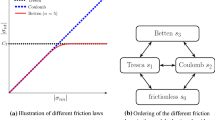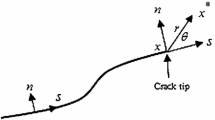Abstract
In this paper a finite element formulation for frictionless contact problems with non-matching meshes in the contact interface is presented. It is based on a non-standard variational formulation due to Nitsche and leads to a matrix formulation in the primary variables. The method modifies the unconstrained functional by adding extra terms and a stabilization which is related to the classical penalty method. These new terms are characterized by the presence of contact forces that are computed from the stresses in the continuum elements. They can be seen as a sort of Lagrangian-type contributions. Due to the computation of the contact forces from the continuum elements, some additional degrees-of-freedom are involved in the stiffness matrix parts related to contact. These degrees-of-freedom are associated with nodes not belonging to the contact surfaces.
Similar content being viewed by others
References
Becker R, Hansbo P (1999) A finite element method for domain decomposition with non-matching grids. Technical Report No. 3613, INRIA, Sophia Antipolis
Becker R, Hansbo P and Stenberg R (2003). A finite element method for domain decomposition with non-matching grids. Math Model Numer Anal 37(2): 209
Belgacem FB (1999). The mortar finite element method with lagrange multipliers. Numerische Mathematik 84: 173–197
Belgacem FB, Hild P and Laborde P (1999). Extensinos of the mortar finite element method to a variational inequality modelling unilateral contact. Math Methods Appl Sci 9: 287–303
El-Abbasi N and Bathe KJ (2001). Stability and patch test performance of contact discretizations and a new solution algorithm. Comput Struct 79: 1473–1486
Hansbo A and Hansbo P (2002). An unfitted finite element method, based on Nitsche’s method, for elliptic interface problems. Comput Methods Appl Mech Eng 191(47): 5537–5552
Johnson KL (1985). Contact mechanics. Cambridge University Press, London
McDevitt TW and Laursen TA (2000). A mortar-finite element formulation for frictional contact problems. Int J Numer Methods Eng 48: 1525–1547
Nitsche J (1970). Über ein Variationsprinzip zur Lösung von Dirichlet-Problemen bei Verwendung von Teilräumen, die keinen Randbedingungen unterworfen sind. Abhandlungen in der Mathematik an der Universität Hamburg 36: 9–15
Papadopoulos P and Taylor RL (1992). A mixed formulation for the finite element solution of contact problems. Comput Methods Appl Mech Eng 94: 373–389
Parisch H (1989). A consistent tangent stiffness matrix for three-dimensional non-linear contact analysis. Int J Numer Methods Eng 28: 1803–1812
Pietrzak G and Curnier A (1999). Large deformation frictional contact mechanics: continuum formulation and augmented lagrangean treatment. Comput Methods Appl Mech Eng 177: 351–381
Simo JC and Laursen TA (1992). An augmented Lagrangian treatment of contact problems involving friction. Comput Struct 42: 97–116
Simo JC, Wriggers P and Taylor RL (1985). A perturbed Lagrangian formulation for the finite element solution of contact problems. Comput Methods Appl Mech Eng 50: 163–180
Stenberg R (1995). On some techniques for approximating boundary conditions in the finite element method. J Comput Appl Math 63(1-3): 139–148
Wriggers P (1995). Finite element algorithms for contact problems. Arch Comput Methods Eng 2: 1–49
Wriggers P (2006). Computational contact mechanics. Springer, Berlin
Wriggers P and Simo J (1985). A note on tangent stiffnesses for fully nonlinear contact problems. Commun Appl Numer Methods 1: 199–203
Wriggers P and Zavarise G (1993). On the application of augmented lagrangian techniques for nonlinear constitutive laws in contact interfaces. Commun Appl Numer Methods 9: 815–824
Zavarise G, Boso D and Schrefler B (2002). A contact formulation for electrical and mechanical resistance. In: Martins, J and Marques, MDM (eds) Contact mechanics, pp 211–218. Kluwer, Dordrecht
Zavarise G and Wriggers P (1998). A segment-to-segment contact strategy. Math Comput Model 28: 497–515
Zavarise G, Wriggers P and Schrefler BA (1998). A method for solving contact problems. Int J Numer Methods Eng 42: 473–498
Zienkiewicz OC and Taylor RL (2000). The finite element method, vol 1. Butterworth-Heinemann, Oxford
Author information
Authors and Affiliations
Corresponding author
Rights and permissions
About this article
Cite this article
Wriggers, P., Zavarise, G. A formulation for frictionless contact problems using a weak form introduced by Nitsche. Comput Mech 41, 407–420 (2008). https://doi.org/10.1007/s00466-007-0196-4
Received:
Accepted:
Published:
Issue Date:
DOI: https://doi.org/10.1007/s00466-007-0196-4




